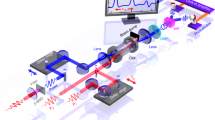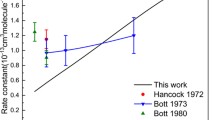Abstract
The rate constants for rotational excitation, the coefficient of RT diffusion for the Ar-N2 system, and the rotational relaxation time in N2 are calculated using the quasiclassical approximation.
Similar content being viewed by others
Literature cited
G. V. Dubrovskii and A. V. Bogdanov, “A general quasiclassical approximation of the T operator in action-angle variables,” Chem. Phys. Lett.,62, No. 1, 89–94 (1979).
G. V. Dubrovskii and L. F. V'yunenko, “Theory of vibrational-rotational excitation of diatomic molecules within the framework of the generalized eikonal method,” Zh. Eksp. Teor. Fiz.,80, No. 1, 66–79 (1981).
A. P. Clark, A. S. Dickinson, and D. Richards, “The correspondence principle in heavyparticle collisions,” Adv. Chem. Phys.,36, 63–139 (1977).
G. V. Dubrovskii and A. V. Skorodumov, “Quasiclassical approximation for inelastic atommolecule scattering amplitudes,” Zh. Eksp. Teor. Fiz.,73, No. 1, 76–89 (1977).
A. S. Dickinson and D. Richards, “Rotational excitation of diatomic molecules by atoms,” J. Phys. B: Atom. Molec. Phys.,7, No. 14, 1916–1936 (1974).
E. E. Mikitin and A. I. Osipov, Vibrational Relaxation in Gases [in Russian], VINITI, Moscow (1977).
C. Nyeland and G. D. Billing, “Approximative treatments of rotational relaxation,” Chem. Phys.,40, 103–110 (1979).
S. Lee and Y. S. Kim, “A study of Ar-N2 interaction. II. Modification of the electron gas model potential at intermediate and large distances,” J. Chem. Phys.,70, No. 11, 4856–4863 (1979).
A. E. DePristo and H. Rabitz, “Scaling theoretical deconvolution of bulk relaxation data: State-to-state rates from pressure broadened line widths,” J. Chem. Phys.,68, No. 4, 1981–1987 (1978).
G. V. Dubrovskii, “Simplified kinetic approaches to the dynamics of structurally relaxing gas,” Zh. Tekh. Fiz.,52, No. 10, 1927–1937 (1982).
D. E. Fitz and D. J. Kouri, “On the sudden approximation of cross section: computational tests and factorization of cross sections and related scattering phenomena,” Chem. Phys.,47, No. 2, 195–209 (1980).
S. Lee and Y. S. Kim, “N−2 2 repulsive interaction obtained through a combining rule,” J. Chem. Phys.,73, No. 10, 5131–5134 (1980).
G. E. Prangsma, A. H. Alberga, and J. J. M. Beenakker, “Ultrasonic determination of the volume viscosity of N2, CO, CH4, and CD4 between 77 and 300°K,” Physica,64, No. 2, 248–288 (1973).
E. H. Carnevalle, C. Carey, and G. Larson, “Ultrasonic determination of rotational collision numbers and vibrational relaxation times of polyatomic gases at high temperatures,” J. Chem. Phys.,47, No. 8, 2829–2835 (1967).
C. Nyeland and G. Billing, “Rotational relaxation of homonuclear diatomic molecules by classical trajectory computation,” Chem. Phys.,30, 401–406 (1978).
Author information
Authors and Affiliations
Additional information
Translated from Inzhenerno-Fizicheskii Zhurnal, Vol. 47, No. 2, pp. 300–310, August, 1984.
Rights and permissions
About this article
Cite this article
Dubrovskii, G.V., Pavlov, V.A. & Mukhametzyanov, R.É. Rotational excitation of diatomic molecules in collisions with atoms. Journal of Engineering Physics 47, 971–980 (1984). https://doi.org/10.1007/BF00869705
Received:
Issue Date:
DOI: https://doi.org/10.1007/BF00869705




